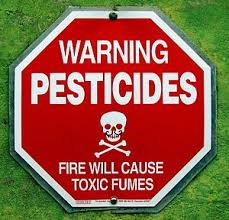Very little is known about human exposure to these chemicals (how much is our exposure?) and their effects on humans, but the data suggest effects similar to that in neurological disorders. The researchers point out that many of the chemical residues in this cluster were found on conventionally raised foods, especially leafy green vegetables, and were detected at relatively high levels, especially pyraclostrobin. Most of these fungicides only came into use after 2000 and usage of these fungicides has been increasing in the U.S, with the exception of pyridaben (decreasing use) and rotenone (very low use). "These data suggest significant human exposure potential to many of the chemicals in cluster 2".
Mark Zylka, PhD, senior author of the study and associate professor of cell biology and physiology at UNC, and his team exposed mouse neurons to approximately 300 different chemicals.... "Based on RNA sequencing, we describe six groups of chemicals," Zylka said. "We found that chemicals within each group altered expression in a common manner. One of these groups of chemicals altered the levels of many of the same genes that are altered in the brains of people with autism or Alzheimer's disease." Chemicals in this group included the pesticides rotenone, pyridaben, and fenpyroximate, and a new class of fungicides that includes pyraclostrobin, trifloxystrobin, fenamidone, and famoxadone. Azoxystrobin, fluoxastrobin, and kresoxim-methyl are also in this fungicide class.
"We cannot say that these chemicals cause these conditions in people," Zylka cautioned. "Many additional studies will be needed to determine if any of these chemicals represent real risks to the human brain." Zylka, a member of the UNC Neuroscience Center, and his group found that these chemicals reduced the expression of genes involved in synaptic transmission -- the connections important for communication between neurons. If these genes are not expressed properly, then our brains cannot function normally. Also, these chemicals caused an elevated expression of genes associated with inflammation in the nervous system. This so-called neuroinflammation is commonly seen in autism and neurodegenerative conditions.
The researchers also found that these chemicals stimulated the production of free radicals -- particles that can damage the basic building blocks of cells and that have been implicated in a number of brain diseases. The chemicals also disrupted neuron microtubules. "Disrupting microtubules affects the function of synapses in mature neurons and can impair the movement of cells as the brain develops," Zylka said. "We know that deficits in neuron migration can lead to neurodevelopmental abnormalities. We have not yet evaluated whether these chemicals impair brain development in animal models or people."
Jeannie T. Lee, MD, PhD, professor of genetics at Harvard Medical School and Massachusetts General Hospital, who was not involved in this research, said, "This is a very important study that should serve as a wake-up call to regulatory agencies and the general medical community. The work is timely and has wide-ranging implications not only for diseases like autism, Parkinson's, and cancer, but also for the health of future generations. I suspect that a number of these chemicals will turn out to have effects on transgenerational inheritance."
Zylka's group also analyzed information from the U.S. Geological Survey, which monitors countywide pesticide usage, as well as the Food and Drug Administration and the U.S. Department of Agriculture, which test foodstuffs yearly for pesticide residues. Of the chemicals Zylka's team studied, only the usage of pyridaben has decreased since 2000. Rotenone use has remained the same since 2000. However, the use of all the fungicides in this group has increased dramatically over the past decade.
Indeed, a study from the Environmental Protection Agency found that pyraclostrobin is found on foods at levels that could potentially affect human biology, and another study linked pyraclostrobin usage to honeybee colony collapse disorder. The pesticide rotenone was previously implicated in Parkinson's disease through replicated animal experiments and through human epidemiological studies.....Previous work has also shown that a single dose of the fungicide trifloxystrobin reduced motor activity for several hours in female rats and for days in male rats. Disrupted motor function is a common symptom of Parkinson's disease and other neurological disorders. The related fungicide picoxystrobin impaired motor activity in rats at the lowest dose tested.
Zylka added, "The real tough question is: if you eat fruits, vegetables or cereals that contain these chemicals, do they get into your blood stream and at what concentration? That information doesn't exist." Also, given their presence on a variety of foodstuffs, might long term exposure to these chemicals -- even at low doses -- have a cumulative effect on the brain?
Zylka noted that conventionally grown leafy green vegetables such as lettuce, spinach, and kale have the highest levels of these fungicides. But due to each chemical's effectiveness at reducing fungal blights and rust, crop yields have increased and farmers are expanding their use of these chemicals to include many additional types of food crops.
Zylka's team hopes their research will encourage other scientists and regulatory agencies to take a closer look at these fungicides and follow up with epidemiological studies. "Virtually nothing is known about how these chemicals impact the developing or adult brain," Zylka said. "Yet these chemicals are being used at increasing levels on many of the foods we eat."
 Applying fungicide to apple orchard. Credit: Univ. of Kentucky Agriculture Extension
Applying fungicide to apple orchard. Credit: Univ. of Kentucky Agriculture Extension
 Update to the toxic pesticide acephate story of last week. Well, well, well.... Due to the big outcry after ProPublica's story exposing EPA's recent decision to relax standards and so allow much more of the toxic pesticide acephate in our food, the officials at the EPA changed their minds and now propose banning it!
Update to the toxic pesticide acephate story of last week. Well, well, well.... Due to the big outcry after ProPublica's story exposing EPA's recent decision to relax standards and so allow much more of the toxic pesticide acephate in our food, the officials at the EPA changed their minds and now propose banning it! 

 A
A  Applying fungicide to apple orchard. Credit: Univ. of Kentucky Agriculture Extension
Applying fungicide to apple orchard. Credit: Univ. of Kentucky Agriculture Extension A large study found that using antidepressants during the second or third trimester of pregnancy increases the risk that the child will have autism by 87%, especially if the mother takes selective serotonin reuptake inhibitors (SSRIs). A drawback was that the study looked at associations rather than actual cause (which would have meant randomly assigning women to either treatment or no treatment - which is unethical). From Medical Xpress:
A large study found that using antidepressants during the second or third trimester of pregnancy increases the risk that the child will have autism by 87%, especially if the mother takes selective serotonin reuptake inhibitors (SSRIs). A drawback was that the study looked at associations rather than actual cause (which would have meant randomly assigning women to either treatment or no treatment - which is unethical). From Medical Xpress: Two studies finding various forms of air pollution having effects on the developing fetus - the first one (fine particulate air pollution) to autism, and the second (outgassing of new flooring) to later breathing problems.
Two studies finding various forms of air pollution having effects on the developing fetus - the first one (fine particulate air pollution) to autism, and the second (outgassing of new flooring) to later breathing problems.